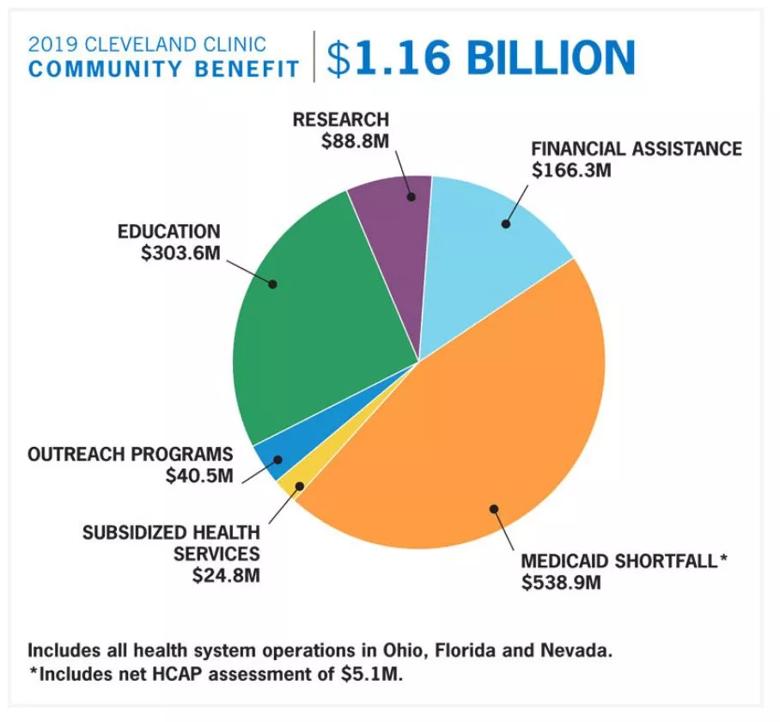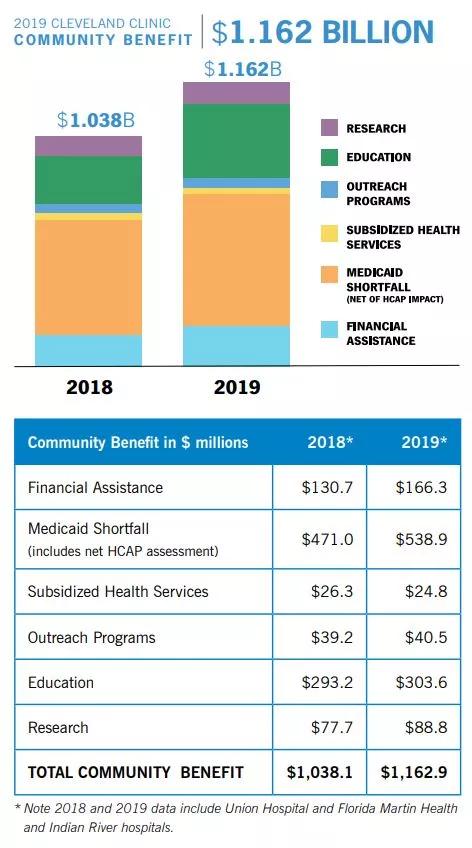The health system is committed to promoting access to healthcare and healthy behaviors in the community

Cleveland Clinic’s total community benefit increased 12% to $1.16 billion in 2019, representing the highest level of community benefit in its reporting history and includes all health system operations in Ohio, Nevada and Florida.

Community benefit is a measure of a hospital’s investment in its community through education, research, financial assistance and Medicaid shortfall, subsidized services, and outreach programs. It is one indicator of Cleveland Clinic’s commitment to its neighbors.
“Our goal is to make every community we serve the healthiest possible,” said Cleveland Clinic CEO and President Tom Mihaljevic, M.D. “Community benefit is one way to measure progress. It shows how our care for patients and commitment to our neighbors go hand-in-hand.”
As a nonprofit hospital system, Cleveland Clinic is a community asset with no owners, investors or stockholders. Any and all extra funds from operations are invested back into the health system to support patient care, research, education and long-standing charitable efforts.
Community benefit data is calculated in accordance with IRS Form 990 reporting guidelines. The primary categories for assessing community benefit include:
Financial Assistance – $166.3 million

Cleveland Clinic’s financial assistance – free or discounted medical care provided to those patients unable to pay some or all of their bills – increased 27% from 2018 to 2019.
Cleveland Clinic provides free or discounted care to patients with incomes up to 400 percent of the federal poverty level and covers both hospital care and employed physician services.
Medicaid Shortfall – $538.9 million
Cleveland Clinic experienced a 17% increase in Medicaid shortfall from 2018 to 2019. Funded by state and federal governments, Medicaid provides healthcare coverage for low-income families and individuals. As a result of implementation of the Affordable Care Act, which requires individuals to obtain healthcare insurance, hospitals across the United States saw an increase in the number of individuals covered by Medicaid or health exchange policies.
Subsidized Health Services – $24.8 million
Excluding financial assistance costs and Medicaid shortfalls, Cleveland Clinic provided subsidized health services in 2019 at a cost of $24.8 million. In 2018, it was $26.3 million. Cleveland Clinic’s subsidized health services include behavioral health, obstetrics and chronic disease management.
Outreach Programs – $40.5 million
In 2019, support for outreach programs increased from $39.2 million in 2018 to $40.5 million. Cleveland Clinic outreach programs align with community needs and focus on chronic disease prevention and management, mental health and substance abuse, health equity and socioeconomic concerns.
Examples include:
Health Professions Education – $303.6 million
For 2019, Cleveland Clinic’s total expenditure in support of education was $303.6 million, an increase of more than 3% from $293.2 million in 2018. Cleveland Clinic education initiatives cover a wide range of medical education programs, including accredited training programs for residents, physicians, nurses and allied health professionals. By educating medical professionals, we ensure that the public is receiving the highest standard of medical care and will have highly trained health professionals to care for them in the future.
Research – $88.8 million
Cleveland Clinic’s contribution for medical research increased 14% to $88.8 million in 2019 from $77.7 million in 2018. Research into diseases and cures is an investment in society’s long-term health. From a community benefit standpoint, research includes basic, clinical and community health, as well as studies on healthcare delivery. With nearly 1,500 researchers and support personnel in 190 laboratories in 10 departments, Lerner Research Institute scientists perform laboratory-based, translational and clinical research.
“Collaboration with the community cannot be done in isolation,” Dr. Mihaljevic said. “Cleveland Clinic proactively engages our community partners to determine how to make the most positive impact. We are intent on giving back, uplifting our neighborhoods, and contributing to the social fabric of our communities.”
The 2019 community benefit of $1.16 billion is 12% higher than 2018’s total of $1.04 billion.
Read or download the entire community benefit report here.
Cleveland Clinic is a nonprofit multispecialty academic medical center that integrates clinical and hospital care with research and education. Located in Cleveland, Ohio, it was founded in 1921 by four renowned physicians with a vision of providing outstanding patient care based upon the principles of cooperation, compassion and innovation. Cleveland Clinic has pioneered many medical breakthroughs, including coronary artery bypass surgery and the first face transplant in the United States. Cleveland Clinic is consistently recognized in the U.S. and throughout the world for its expertise and care. Among Cleveland Clinic’s 82,600 employees worldwide are more than 5,786 salaried physicians and researchers, and 20,700 registered nurses and advanced practice providers, representing 140 medical specialties and subspecialties. Cleveland Clinic is a 6,728-bed health system that includes a 173-acre main campus near downtown Cleveland, 23 hospitals, 280 outpatient facilities, including locations in northeast Ohio; Florida; Las Vegas, Nevada; Toronto, Canada; Abu Dhabi, UAE; and London, England. In 2024, there were 15.7 million outpatient encounters, 333,000 hospital admissions and observations, and 320,000 surgeries and procedures throughout Cleveland Clinic’s health system. Patients came for treatment from every state and 112 countries. Visit us at clevelandclinic.org. Follow us at x.com/CleClinicNews. News and resources are available at newsroom.clevelandclinic.org.
Editor’s Note: Cleveland Clinic News Service is available to provide broadcast-quality interviews and B-roll upon request.